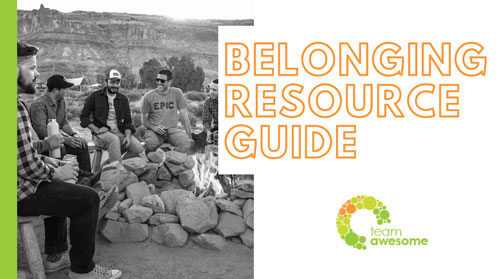So, I wrote “inclusion” in the title because that is the word that your brain is used to searching for. But what I really want to discuss is “belonging.”
I recently read and loved this article, “How LinkedIn’s HR Chief is Changing the Diversity Conversation with “Belonging”” from LinkedIn posted in January 2017. To me, the traditional definition companies often give “diversity and inclusion” felt somehow, exclusive. Of what, I couldn’t put my finger on. But as we reconfigure this idea as “belonging,” it becomes so simple and clear. It can be defined as a sense of belonging, as simple as that. That is easily tied back to employee engagement, turnover, and everything else you measure as well as everything you didn’t think to measure. Such as when introverts didn’t feel understood, when democratic-style leaders were fed up with their directive-style leaders, or despite the LGBTQ affinity group you had in place there still seemed to be a lack of belonging.
If we let go of our old definitions of D&I and focus on creating belonging, how might our workplace be different? And how do we get there?
The LinkedIn article offers some amazing ideas on how to do this, but I would distill this down even further to one key component: Communication. Let me point out a few things things suggested in Kate Reilly’s article that relate to communication:
- listen better during interviews
- put away your devices
- host town halls on sensitive topics
- measure belonging as part of your employee engagement research (e.g. ask for feedback)
But this needs to go so much deeper than the organizational level. As leaders, we each make choices on how we show up, and how we communicate. That means how we actively listen, the body language we use, and the things we choose to share with our teams. Sharing appropriately about yourself as a person, and making sure that you regularly communicate what is going on in the business are critical to your team’s engagement and sense of belonging.
I’ll share two examples of when I heard feedback of employees in their workplaces feeling a lack of belonging, tied back to communication.
Mary in accounts payable once told me that it was frustrating to hear about marketing campaigns and customer promotions from the news rather than internal leaders. Neighbors would ask her, “What is that [fill in the blank] program about?” and she would feel like an outsider that she didn’t know before the general public and couldn’t answer questions from her friends and family. This damaged her sense of belonging.
Tony had a leader that (in his words) did a great job communicating what the priorities are, and what was happening in all aspects of the business. When his leader left, he suddenly realized that he no longer had this stream of communication of what was going on around him. Suddenly he felt like an island, and didn’t feel like he belonged enough anymore for someone to bother telling him what was happening in the company.
We can do better.
If we take a more inclusive approach like belonging, and use communication as a main tool to create it, we can transform the workplace. Leaders are doing this already every day. But we need more leaders to step up and tip their company cultures towards belonging and effective communication. Find one first step to being more open and available in your communication, and see how it feels. How are you creating belonging on your team?



Trackbacks/Pingbacks